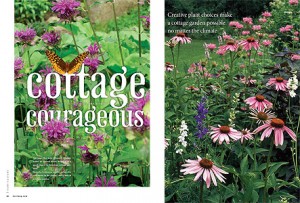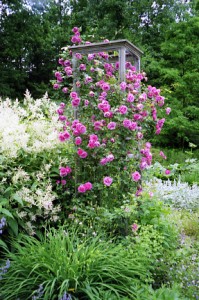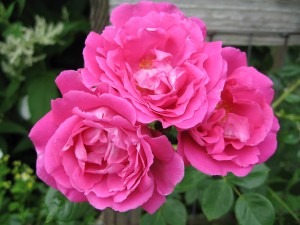Featured in Horticulture
April 19, 2010 by admin
Filed under Cottage Gardening

All you Horticulture magazine readers out there may already have noticed a certain familiar cottage garden in the May issue. Yup—that’s my baby, the same garden I showcase in my Connecticut Cottage Garden lecture, and the same one you’ve seen here in some other posts under the Cottage Gardening heading.
 Writing the article was a good exercise for me, because it forced me to focus and condense all the ideas I want to convey about cottage gardening into a few broad principles, which themselves all boiled down to one overarching piece of advice: use the plants that are best suited to your climate, your available time, energy and budget, and your specific site. Sometimes you can only discover what those are by trying something out, but most of the time it’s pretty predictable what will work and what won’t.
Writing the article was a good exercise for me, because it forced me to focus and condense all the ideas I want to convey about cottage gardening into a few broad principles, which themselves all boiled down to one overarching piece of advice: use the plants that are best suited to your climate, your available time, energy and budget, and your specific site. Sometimes you can only discover what those are by trying something out, but most of the time it’s pretty predictable what will work and what won’t.
The basic problem is that you can’t take the traditional English cottage garden plant palette, plunk it down wholesale in the Northeast and expect it to work. As I often say, England and New England may have a name in common, but when it comes to gardening the resemblance is strained.
The English climate (although of course it varies) is milder, cooler and more predictable than ours, which makes their plant palette more extensive. There, many plant diseases are easier to control precisely because the English climate is not as conducive to their development. And for the love of Pete, they don’t even have Japanese beetles! It really is easier to garden there!
One subject I cover in the article that I haven’t broached yet in this blog is the idea that you’ll save yourself a lot of unnecessary heartache, not to mention time and money, if you don’t get too hung up on growing traditional cottage garden plants if they just don’t do well here, for whatever reason. Instead, look for reasonable substitutes that are reliable.
Here’s one example. Early in my cottage garden’s history, I planted a number of reblooming shrub roses. Bad idea. Not only were they Japanese beetle magnets, but they also had a hard time fending off their neighbors. I intentionally included a lot of large, leafy perennials in my cottage garden because their height and mass give the space privacy and separation from some busy surroundings. All well and good, but everyone knows roses don’t like crowding. They suffered, and eventually I removed them.

Rosa 'Cl. American Beauty' living up to her name.
But one rose remained and has been a highlight of the garden right from the start. Ironically, it was moved there from another garden where it wasn’t getting enough light. While the other roses declined, it found its stride and developed into a stunning specimen. It’s a ‘Cl. American Beauty,’ and you can see in the photo at left how impressive it can be.
So what made this one rose different? Several things. First, it’s a climbing rose. I grow it on an 8′ tall cedar pillar with hardware cloth sides. Grown that way, most of its foliage is up above the plants that surround it instead of struggling to grow out from underneath. Plus, the open structure of the pillar promotes air circulation, which discourages disease.
Second, it’s an early flowering, once-blooming rose. Your first reaction might be disappointment, but it shouldn’t be. It’s true that this rose will bloom for a shorter time than reblooming roses. However—and this is an important however—it blooms during the first three weeks of June, before the Japanese beetles emerge! I may get only three weeks of flowers, but I get three weeks of perfect, unmolested flowers with no nasty holes gnawed into the buds. I’ll take that any day over months of half chewed, pesticide soaked flowers on rebloomers.
It should go without saying that ‘Cl. American Beauty’ is naturally quite disease resistant and cold hardy in Connecticut. You should always select perennial and woody plants for cold hardiness and disease resistance.
Now, some of you might say that a once-blooming rose isn’t an alternative to a traditional cottage garden plant—it is a traditional cottage garden plant! And you’d be half right. Although ‘Cl. American Beauty’ is a cross introduced in the early 1900s, it has more in common with truly old roses than it does with most modern ones. The point is that a lot of gardeners either might not know or might not make the time to find out what kind of rose is most likely to succeed in a given garden. They’d just go to a nursery and pick one they liked. That’s understandable, because it’s easy to have your socks knocked off by some trendy plant fresh from the grower looking better than it ever will again because of all the protection, coddling and extraordinary care it’s received. Can you give it that same level of care? Probably not. Better to choose something that doesn’t need all that extra care.
My ‘Cl. American Beauty’ doesn’t need to be sprayed with fungicides, and it doesn’t require that I take any measures against Japanese beetles. Oh, and by the way…its fragrance is heavenly! As roses for cottage gardens go, I couldn’t ask for more.



Just the thought of having a rose in bloom BEFORE the Japanese beetles appear is enough to make me give serious consideration to ‘Cl. American Beauty.'(Great movie too.) I’d have to find the right arbor or pillar, how’d you make your “8′ tall cedar pillar with hardware cloth sides.” And what’s “hardware cloth?” If its aroma comes close to ‘Gertrude Jekyll’ I’d be most happy.
So, are you saying I have a convert? ☺
A great source for high quality old and not-so-old roses (and information about them) is the Antique Rose Emporium. They’re a specialty grower in Texas that sells mail order, which is how I got my ‘Cl. American Beauty’. Of course, I also advise checking out rose forums online and especially trying to make contact with a knowledgeable local rosarian (public rose gardens and arboreta are good places to start) before committing to a specific rose for a particular locale.
I haven’t got much of a “smell memory,” so I can’t say how close the fragrance of ‘Cl. American Beauty’ comes to that of ‘Gertrude Jeckll’, but I can assure you that it’s pure bliss!
A lot of people have shown interest in the details of my cedar pillar. To do it justice, I’ll write a detailed post about its construction in the near future. Stay tuned.